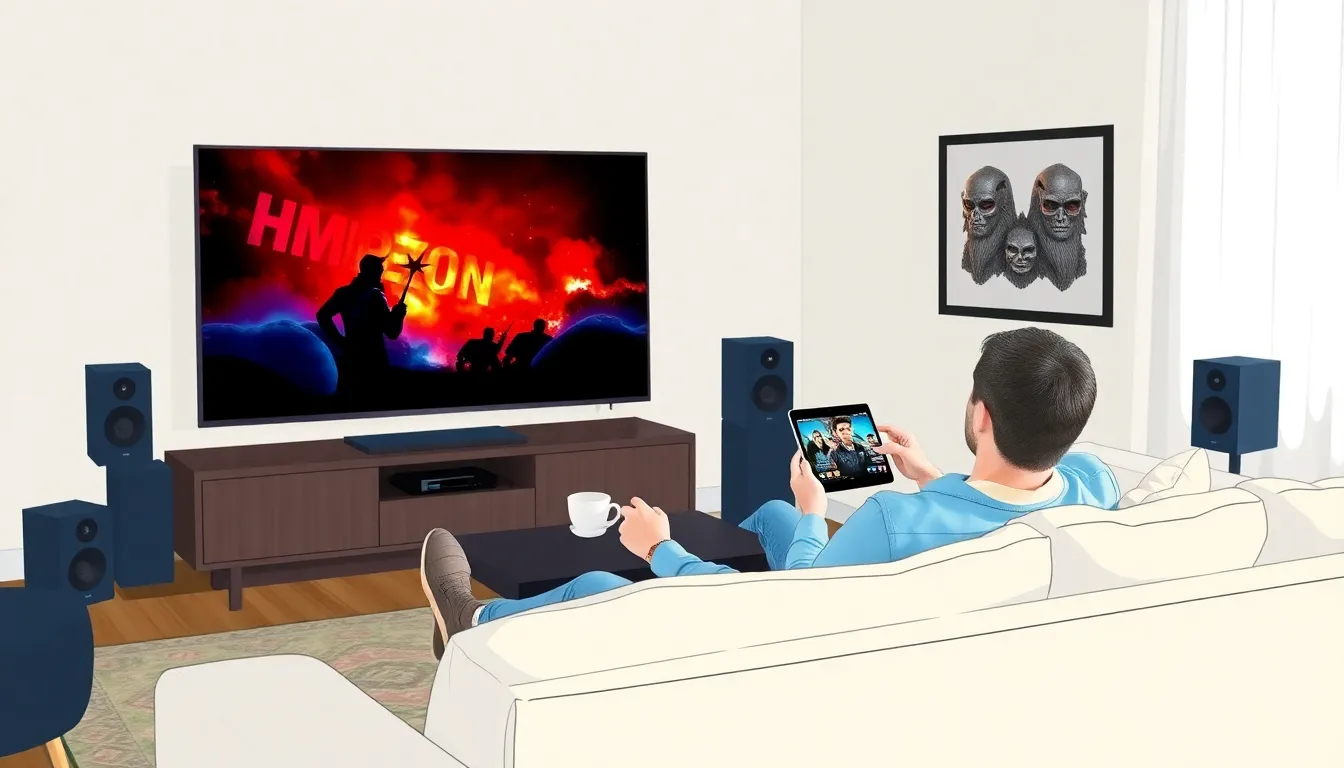In a world where tangled cords and clunky devices are as outdated as dial-up internet, wireless entertainment has swooped in like a superhero ready to save the day. Imagine kicking back on your couch, remote in hand, while your favorite shows stream seamlessly through the air. No more wrestling with wires or tripping over cables—just pure, unadulterated enjoyment at your fingertips.
Table of Contents
ToggleOverview of Wireless Entertainment
Wireless entertainment encompasses a range of devices and services that allow users to enjoy media without physical connections. Streaming platforms such as Netflix, Hulu, and Disney+ dominate the landscape, providing access to vast libraries of content on various devices. Smart TVs simplify viewing experiences by integrating Wi-Fi capabilities, enabling users to stream content directly without additional hardware.
Bluetooth technology supports many wireless audio devices. Earbuds, headphones, and speakers benefit from Bluetooth’s convenience, creating a seamless audio experience. Customers enjoy high-quality sound without the clutter of cables. Voice-controlled smart speakers also integrate with streaming services, allowing hands-free operation when selecting music or podcasts.
Mobile devices play a significant role in wireless entertainment. Smartphones and tablets allow users to watch videos on the go, providing flexibility in viewing choices. Additionally, apps like Spotify and Apple Music offer expansive music libraries, allowing users to curate playlists and discover new artists.
Wireless gaming has gained traction with consoles and computers. Online multiplayer gaming permits players to connect and compete without the limitations of wired connections. Platforms like PlayStation Network and Xbox Live enhance social interaction among gamers across the globe.
Wireless technologies, including Wi-Fi 6 and 5G networks, continue to enhance entertainment experiences. Increased bandwidth ensures smooth streaming, while reduced latency improves real-time interactions in gaming. These advancements solidify the importance of wireless entertainment in today’s digital world.
Benefits of Wireless Entertainment

Wireless entertainment offers numerous advantages, primarily rooted in convenience and enhanced user experiences.
Convenience and Flexibility
Convenience defines wireless entertainment, allowing users to enjoy media without the limitations of cords. Users can move freely in their spaces, eliminating the hassle of tangled wires. Flexibility enhances this experience, as devices connect seamlessly across platforms. Smart TVs, laptops, and mobile devices access extensive libraries like Netflix or Hulu through Wi-Fi. Additionally, users stream content anywhere, whether in a living room or during travel. Devices like smartphones enable users to transition smoothly between watching shows and listening to music. With wireless technology, accessing favorite content becomes instant and hassle-free.
Enhanced User Experience
Enhanced user experiences emerge from the integration of wireless technology in entertainment. High-quality audio results from Bluetooth headphones or speakers, providing an immersive sound environment. Voice-controlled smart speakers enable hands-free interaction, simplifying the streaming process significantly. Users can control playback simply by speaking commands. Moreover, fast internet connections powered by advancements like Wi-Fi 6 improve streaming quality and reduce buffering times. Gamers benefit as well, enjoying seamless online play through platforms like PlayStation Network and Xbox Live. Comprehensive features associated with wireless entertainment foster enjoyment and engagement, making it a preferred choice for many.
Types of Wireless Entertainment
Wireless entertainment encompasses various forms that enhance user experiences across multiple platforms. Several main types include streaming services, wireless gaming, and smart home integration.
Streaming Services
Streaming services offer vast libraries of content without the need for physical media. Platforms like Netflix, Hulu, and Disney+ provide on-demand access to movies and TV shows. Users enjoy seamless streaming on smart TVs, laptops, and mobile devices. With significant investments in original programming, these services attract millions of subscribers seeking diverse entertainment options. Streaming technology adapts to users’ internet speeds, delivering high-quality content while minimizing buffering times.
Wireless Gaming
Wireless gaming revolutionizes how players connect and compete with each other. Platforms like PlayStation Network and Xbox Live enable online multiplayer experiences without cables. Gamers can access a wide range of games and updates with simple downloads. Devices such as wireless controllers enhance comfort and mobility during play. The growing trend of cloud gaming allows users to stream games directly from remote servers, making hardware limitations less of an issue.
Smart Home Integration
Smart home integration simplifies media accessibility through voice commands and automation. Devices like Amazon Echo and Google Nest Hub can control entertainment systems effortlessly. Users can stream music or videos using voice controls, making multitasking easier. Smart TVs often come equipped with built-in streaming technology, reducing the need for additional devices. Integration with smart home ecosystems enhances user convenience, creating an interconnected experience for entertainment at home.
Challenges and Limitations
Wireless entertainment, while revolutionary, presents several challenges that users must navigate.
Connectivity Issues
Connectivity can vary significantly based on location and network conditions. Users often experience unstable connections, which lead to interruptions during streaming or gaming. Interference from physical barriers, like walls or electronic devices, can weaken signals further. Additionally, the reliability of internet service providers plays a significant role in users’ overall experience with wireless technology. Users in rural areas may face slower speeds and higher latency compared to urban counterparts. These connectivity issues impact the quality of video streams and online gaming, causing frustration.
Device Compatibility
Device compatibility poses another challenge in the landscape of wireless entertainment. Different devices may not work seamlessly with various streaming services or platforms. For example, not all smart TVs support certain apps or codecs, limiting content access. Older devices may struggle to connect with the latest wireless standards, affecting performance. Users may find themselves navigating complicated settings to ensure proper functionality. As manufacturers release new models regularly, maintaining compatibility across devices becomes a complex task. The constant evolution of technology means users might need to regularly upgrade or replace older devices to enjoy a fully integrated wireless experience.
Future Trends in Wireless Entertainment
Emerging trends in wireless entertainment reflect continuous advancements in technology and consumer preferences. Streaming services will increasingly integrate augmented reality (AR) and virtual reality (VR) features, enhancing viewer immersion with interactive experiences. Mobile device manufacturers focus on improving battery life and processing speeds, ensuring seamless streaming for users on the go.
Wireless audio technology advances, with spatial audio becoming more mainstream. Users appreciate 3D sound experiences that adjust to their environments. Smart home integration will gain traction, allowing users to control their entertainment systems through unified platforms. This shift towards smart ecosystems reduces the need for multiple remotes and enhances user convenience.
Cloud gaming is set to redefine gaming experiences. This approach allows players to access high-quality games without expensive hardware requirements. Providers are investing in lower latency and consistent internet speeds, which directly improve gameplay experiences.
Subscription-based models are likely to evolve, with services offering personalized content recommendations based on viewing habits. Consumers favor customized experiences, prompting platforms to leverage data analytics. Gamified features in streaming services may emerge, encouraging user engagement through challenges and rewards.
Artificial intelligence will play a significant role in improving user interfaces, making them more intuitive and responsive. Voice recognition advancements allow users to navigate content effortlessly. Lastly, the rise of 5G technology will support higher data transfer speeds, facilitating smoother streaming and gaming experiences, even in densely populated areas.
The landscape of wireless entertainment continues to evolve rapidly, offering users unparalleled convenience and flexibility. As technology advances, the integration of augmented reality, virtual reality, and enhanced audio experiences will redefine how audiences engage with media.
With the rise of 5G technology and improved cloud gaming capabilities, users can expect even higher quality streaming and gaming experiences. Despite some challenges related to connectivity and device compatibility, the benefits of wireless entertainment far outweigh the drawbacks.
As consumers embrace this new era, staying informed about trends and technologies will ensure they make the most of their entertainment options. The future is bright for wireless entertainment, promising more immersive and personalized experiences for everyone.



